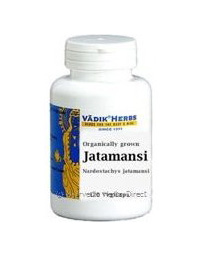
Jatamansi (Nardostachys Jatamansi) is an herbal remedy with a long history. It is one of the few herbs named in the Holy Bible and other historic works show that it was used in India, Greece, Arabia, and Egypt. Jatamansi is in the Valerianaceae family of plants and, historically-speaking, has been used for the treatment of headaches, restlessness, heart palpitations, convulsions, menopausal symptoms, insomnia, and a range of other maladies. Also known as True Spikenard, Biblical Spikenard, and muskroot, Jatamansi grows only at high altitudes on the Alpine side of the Himalaya mountain range. It can be dried or used in the form of an oil extract. Although many scientific studies have been conducted on Jatamansi, it is used primarily today because of its history and biblical presence rather than for any results of scientific investigation. Other uses among the “cure-all” properties of Jatamansi are for complexion, strength, kidney stones, jaundice, blood impurities, gas, digestion, and hair growth.
The Jatamansi plant contains several alkaloids and active chemicals, but only a few of them have been isolated for study. Most medicinal value seems to derive from the rhizomes, which are the parts of the stem that lie underground, and the roots that are attached to the rhizomes. Many of the chemicals contained in natural Jatamansi are categorized as sesquiterpenes and coumarins. Sesquiterpenes are natural hydrocarbons that serve either as attractants or repellents in defense or as pheromones. Coumarins are sweetly-scented compounds found in some plants that are primarily used for perfumes but some also have anticoagulant properties. Specifically, Jatamansi contains sesquiterpene valeranone which does have sedative properties and is also found in active valerian root.
Most information on Jatamansi say there are no known side effects and that it is safe to take but the individual compounds found in Jatamansi are not so inert and there are known side effects, some of which can be rather serious. Coumarin is known to be a poison in sufficient doses and can damage the liver and kidneys to the level of complete failure. It is used as an ingredient in many pesticides focusing on rodents because it causes internal hemorrhaging to the point of death. Human tolerance has been measured at .1 mg per kg of body weight. The real danger with Jatamansi is that there are no available dosage indications of the herb. There are guidelines but fast and hard rules have yet to be established. Counter-indications for the use of Jatamansi say that anyone with liver damage, kidney damage, cancer, epilepsy, and women who are pregnant or nursing should avoid its use. In addition, Jatamansi should not be taken without consulting a physician.
Jatamansi is relatively easy to find online and in stores, but evidence shows that this will not always be true. Jatamansi is listed as a critically endangered plant and restrictions on its cultivation and sale may be implemented in the near future. For now, leading brands sell for $18.95 for a 100-count bottle with minor $1 discounts on quantities by the dozen or half-dozen. Many will guarantee the product to be organic and of the highest quality but there are no standards in place to measure Jatamansi quality. Additionally, Jatamansi can be found as a tea, to be infused in hot water, but this form is marketed mostly as a treatment for indigestion.
Any herb with a history going as far back as Jatamansi and continues to be used today is usually done so for a reason. Sedative effects similar to valerian root are reported but they differ in that the effect of Jatamansi is a wakeful and alert sedation and it provides mental stimulation. Another reason to be wary of Jatamansi is that its history has made it a mythological panacea and in reality, no such cure-alls exist. Jatamansi is rarely marketed as a remedy for insomnia. Instead, insomnia is just one symptom in a long list, most of which remain unproven.